

Anatomy & Physiology - a learning initiative (under construction) Why does lactic acid build up in muscles? And why does it cause soreness? Stephen M.
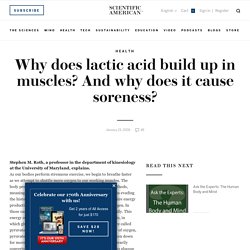
Roth, a professor in the department of kinesiology at the University of Maryland, explains. As our bodies perform strenuous exercise, we begin to breathe faster as we attempt to shuttle more oxygen to our working muscles. The body prefers to generate most of its energy using aerobic methods, meaning with oxygen. Some circumstances, however, --such as evading the historical saber tooth tiger or lifting heavy weights--require energy production faster than our bodies can adequately deliver oxygen. In those cases, the working muscles generate energy anaerobically.
A side effect of high lactate levels is an increase in the acidity of the muscle cells, along with disruptions of other metabolites. Contrary to popular opinion, lactate or, as it is often called, lactic acid buildup is not responsible for the muscle soreness felt in the days following strenuous exercise. Respiratory & Cardiovascular Physiology. Respiratory System In the human body, a division of labour has evolved so that there are numerous different types of cell, each highly specialised and adapted for a particular function.
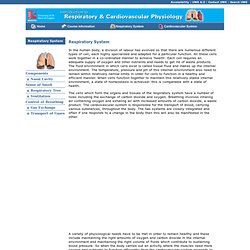
All these cells work together in a co-ordinated manner to achieve ‘health’. Each cell requires an adequate supply of oxygen and other nutrients and needs to get rid of waste products. The fluid environment in which cells exist is called tissue fluid and makes up the internal environment. The temperature, pressure and pH of this internal environment also need to remain within relatively narrow limits in order for cells to function in a healthy and efficient manner. Physiological effects of exercise. Deborah Anne Burton, FRCA, Lecturer in Anaesthesia Keith Stokes, BSc PhD, Lecturer in Sport and Exercise Science George M Hall, MBBS PhD DSc FRCA, Professor of Anaesthesia + Author Affiliations Tel: 020 87252615, Fax: 020 87250256, E-mail: ghall@sghms.ac.uk (for correspondence) Abstract The physiological response to exercise is dependent on the intensity, duration and frequency of the exercise as well as the environmental conditions.
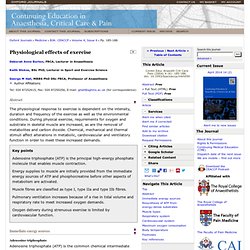
Key points Adenosine triphosphate (ATP) is the principal high-energy phosphate molecule that enables muscle contraction. Energy supplies to muscle are initially provided from the immediate energy sources of ATP and phosphocreatine before other aspects of metabolism are activated. Muscle fibres are classified as type I, type IIa and type IIb fibres. Pulmonary ventilation increases because of a rise in tidal volume and respiratory rate to meet increased oxygen demands. Oxygen delivery during strenuous exercise is limited by cardiovascular function. Glycolysis Table 1 ). Knee injuries - cruciate ligament. Osteoporosis Screening. Osteoporosis is now recognised as a major public health problem, involving enormous costs to the individual, to the NHS (750 million a year) and to society.
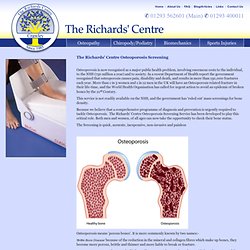
In a recent Department of Health report the government recognised that osteoporosis causes pain, disability and death, and results in more than 150,000 fractures each year. More than 1 in 3 women and 1 in 12 men in the UK will have an Osteoporosis related fracture in their life-time, and the World Health Organisation has called for urgent action to avoid an epidemic of broken bones by the 21st Century. This service is not readily available on the NHS, and the government has ‘ruled out’ mass screenings for bone density. Because we believe that a comprehensive programme of diagnosis and prevention is urgently required to tackle Osteoporosis. The Richards' Centre Osteoporosis Screening Service has been developed to play this critical role. Physical Activity Exercise's Effects on Bones and Muscles - Physical Activity Health Information - NY Times Health.
What is osteoarthritis? Back to Osteoarthritis (OA) Osteoarthritis is a condition that affects your joints.
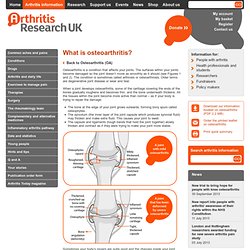
The surfaces within your joints become damaged so the joint doesn’t move as smoothly as it should (see Figures 1 and 2). The condition is sometimes called arthrosis or osteoarthrosis. Older terms are degenerative joint disease or wear and tear. Rheumatoid Arthritis Complications and Effects on the Body. Think of rheumatoid arthritis (RA) and you probably think of the stiff, painful, and inflamed joints that characterize the disease.
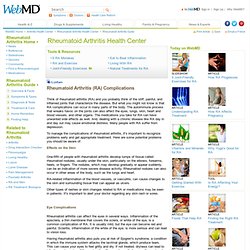
But what you might not know is that RA complications can occur in many parts of the body. The autoimmune process that wreaks havoc on the joints can also affect the eyes, lungs, skin, heart and blood vessels, and other organs. The medications you take for RA can have unwanted side effects as well. And, dealing with a chronic disease like RA day in and day out may cause emotional distress. Many people with RA suffer from depression. To manage the complications of rheumatoid arthritis, it's important to recognize problems early and get appropriate treatment. Long term effects of exercise on musculoskeletal system.